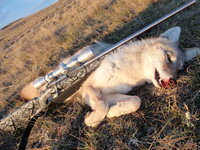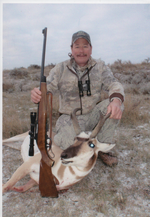- Thread Starter
- #21
I know, Im typically flexible on that once the subject has been covered or answered.C'mon Koda. Off topic is what we do best around here.
Follow along with the video below to see how to install our site as a web app on your home screen.
Note: This feature may not be available in some browsers.
I know, Im typically flexible on that once the subject has been covered or answered.C'mon Koda. Off topic is what we do best around here.
In my case I do like heavy for caliber bullets in my mind at reasonable distances I think they hit harder. For my 300 the 180's and 200's are close enough that I just want to load the ones my rifle likes best.Energy is a component of ballistics and does affect terminal performance thats just science. You can have the best bullet design for penetration but at some point there is a minimum amount of energy required to punch thru heavy bone for example.
I dont really want to go down the rabbit hole of whats the least amount of energy or caliber to ethically hunt with. Im more interested in learning if differences in energy have a significant impact on terminal performance to influence choosing a bullet to handload and hunt with. It may very well be in most big game calibers energy will always be above a certain threshold, but then why do people often choose a heavier bullet?
This is what Im thinking and just trying to justify putting the idea of switching to rest.If you have a dialed-in load, going to a different bullet makes little sense.
Do you have any estimates/opinion on what different energy values affect your choice on choosing a bullet weight?3) Energy is CERTAINLY a factor in killing power and is not "meaningless". Never an "acid test" for killing power (as was done frequently in the past, even by Game Commissions writing caliber regulations) it is only a segment of the characteristics of a projectile that result in a kill. Energy contributes to penetration. Energy contributes to expansion. "Super bullets" enjoy no magic exemption. Energy's contribution to the killing process cannot in any way be written off as without meaning.
Energy is a component of ballistics and does affect terminal performance thats just science.
I dont really want to go down the rabbit hole of whats the least amount of energy or caliber to ethically hunt with. Im more interested in learning if differences in energy have a significant impact on terminal performance to influence choosing a bullet to handload and hunt with. It may very well be in most big game calibers energy will always be above a certain threshold, but then why do people often choose a heavier bullet?
In a given caliber a heavier bullet will likely carry comparable energy and has the ability to penetrate farther/deeper. That's a good trait for an elk hunting bullet.Im pretty much answering my own question here but just wondering if theres something Im not seeing or missing? Is it worth it for me to switch to a heavier bullet for elk?
The first paragraph of my comment was made assuming you were using the same type of bullet in different weights. Heavier weights of the same type of bullet will indeed penetrate deeper and are deflected by brush less than lighter variants of the same type. That is just physics. I agree that bullet selection is very important for application and that needs to be a primary consideration for any load you are working up, but that is not as important when trying to understand the difference between velocity and mass as a physics concept, which is what I was trying to explain first. There are lots of rules of thumb I completely glossed over, like shot placement being far more important than basically all other factors, but again I skipped them because I was concentrating more on the physics of the situation rather than all the other important factors.1) "brush busting capability". THIS is the phrase that needs to be "put to bed". There is no such thing, and there never has been any such thing. As far as traveling through a barrier of brush and arriving at the point of aim (and undamaged toward terminal performance), heavy bullets are NO advantage. Solid bullets are NO advantage.. Large caliber bullets are of NO advantage. Numerous tests have been accomplished regarding this phrase. All conclude that ALL bullets are severely affected by ANY impact on the way to the target. The most comprehensive of these tests (done by Jim Carmichael) came to that conclusion, but did name a "better loser" as to calibers/bullets tried. It was the .264 Winchester magnum with a 140gr hollowpoint. This result illustrates the fallacy of "brush busting capability" best. DON"T shoot through brush.
2) In "olden times" weight of the bullet was the primary factor in penetration. Not today. Bullet design can override a weight advantage toward penetration easily.
3) Energy is CERTAINLY a factor in killing power and is not "meaningless". Never an "acid test" for killing power (as was done frequently in the past, even by Game Commissions writing caliber regulations) it is only a segment of the characteristics of a projectile that result in a kill. Energy contributes to penetration. Energy contributes to expansion. "Super bullets" enjoy no magic exemption. Energy's contribution to the killing process cannot in any way be written off as without meaning.
No charge for this service, Drive Safely.
Energy delivery is a super complex yet important factor in all terminal ballistics. It can be the difference between a killing blow and a wounding blow for the same shot placement. The raw energy contained within the projectile is not the only factor, as energy delivery during the impact is also super important, but you cannot deliver energy you do not have regardless of your terminal performance, so having a lot on arrival just means you have more to work with when trying to damage the target.with todays super bullets why would anybody care about ft. pounds of energy? a meaningless term that should be put to bed.
Which one?so how did your hunt with 256 win mag turn out?


If the accuracy holds up (compared to the old load), and that 150lbs is arrived at with little expense (monetary and effect on the shooter), it seems attractive.Do you have any estimates/opinion on what different energy values affect your choice on choosing a bullet weight?
Lets say you could get 150 more ft/lbs of terminal energy at the distance your comfortable hunting with, would that be enough for you to say it would be better to switch to that bullet
This and other comments confirm energy is a metric of penetration, this makes sense.In a given caliber a heavier bullet will likely carry comparable energy and has the ability to penetrate farther/deeper. That's a good trait for an elk hunting bullet.
There does come a trade off when the bullet is too heavy for the cartridge and loses to much in the way of velocity.
This is where I'm at. FWIW I'm not worried about terminal performance with the Hammer bullets I'm using.If the accuracy holds up (compared to the old load), and that 150lbs is arrived at with little expense (monetary and effect on the shooter), it seems attractive.
But not at the expense of any known terminal performance of the bullet. (If it arrives hitting harder but fails to expand like "Ol' Reliable", there is no benefit.)
Have YOU shot them into anything at range-impact velocities? (I know they're expensive, but I wouldn't rest on the maker's claims.)This is where I'm at. FWIW I'm not worried about terminal performance with the Hammer bullets I'm using.
They came out with a tipped version of my bullet that protects the hollowpoint meplat which is an attractive feature so I'm debating also the heavier option too since my 280ai will be a dedicated elk rifle.
Its difficult to estimate what muzzle velocities I will get in my rifle but when I estimate in a ballistic calculator I'm not seeing huge energy differences with reasonable MV estimates. A slight improvement yes, but I think from this discussion I will probably stay with what I have to save time and money.
For example:
My current load: 140gn Hammer at 3200fps at 600yds gives me 2120fps and 1397ft/lbs of energy.
Their 162gn tipped version at a modest MV estimate of 2900fps results in 2027fps and 1478ft/lbs of energy at 600yds. A difference of 81ftlbs.
note: 600yds for down range comparison only not what I will hunt at. Within reasonable hunting distances the differences is even less. The trade off is probably more recoil.
A heavier bullet will buck the wind better, which will make a big difference over 400-800 yards.This is what Im thinking and just trying to justify putting the idea of switching to rest.
Example: my 280ai elk rifle Im using a 140gn Hammer bullet at 3200fps MV. When I run MV estimates for same bullet but heavier I dont really see a huge improvement in terminal velocity or energy at any distance, its not until I get out past distances Id even consider hunting do I see at least 100ftlbs of improvement in energy.
Im pretty much answering my own question here but just wondering if theres something Im not seeing or missing? Is it worth it for me to switch to a heavier bullet for elk?
No, I recently switched to Hammers and havent used them on game yet. I am not resting my choice on the makers claims, there are many reviews on Hammers out there from hunters that was an influence in my choice to use them.Have YOU shot them into anything at range-impact velocities? (I know they're expensive, but I wouldn't rest on the maker's claims.)
They will a little, but what I understand is BC has more influence on reducing wind drift?A heavier bullet will buck the wind better, which will make a big difference over 400-800 yards.
Run the calcs on your favorite ballistic calculator to get a 'fer instance'.
I find a lot of your experiences and ability to articulate them invaluable. I think this answers my questions for this subject.At the basic level, my Uncle hunted big game his entire life with an '03 Springfield (NOT sporterized).
All his hunting partners (including myself) questioned his choice of 150gr bullets for Elk (actually for everything, and would not change to 180's for Elk).
I just knew that a 165 would be "better", and tried to convince him. HE dug out the factory charts (not a handloader himself) and confirmed for himself (and enlightened me) as to the energy factors.
Equipped with the certain knowledge that a Remington 150gr CorLokt shot clean through every elk he ever killed, as well as noticeable increased recoil for the 180's, he was NOT going to switch. He had accuracy, penetration, expansion and foot-pounds,
And a whole lot of dead elk.
Post Script: (sorry @Koda ) ...and he knew that shooting through brush at unwounded game (and in the absence of a threat) is a fool's errand.